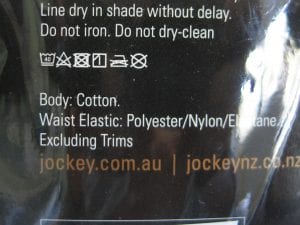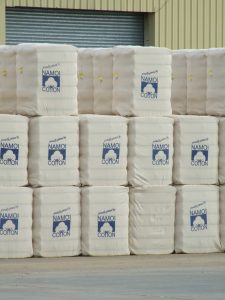# 🙁
There has been a lot of media chat about how bad cotton is lately as well as some less well read facts on how the industry actually performs. As someone who has worked and continues to work closely with the industry and its farmers I have to confess that I find the degree of victimisation and level of accusation, which resulted in a colleague being physically abused recently, is incredibly saddening. We are in a drought and no matter what you might think, the fact that it has not rained is primarily responsible for the state of our rivers and not our farmers, whether they happen to grow cotton on their properties or not.
What you got on today
Some of the rhetoric got me thinking about what some of the people engaged in this provocation were wearing when they were having a go. Nice cotton shirt and probably cotton in their jocks and socks. Looks like a nice fine wool suit, but I wonder if the tie is silk or polyester? Any way, whilst they were banging on about ‘exporting water’ it got me thinking about whether they had considered how much textiles and fabrics we import back into Australia to clothe and comfort our great Cotton (and wool) producing nation? After all, surely if we are exporting water in fibre then we are importing it back in the cloth it goes into making?
The numbers
According to Trading Economics, we exported US$1.6 billion in cotton last year. Not bad, but we imported US $3.18 billion of ‘articles of apparel not knit or crocheted’, $1.14 billion of ‘other made textile articles, sets, worn clothing’ and $450 million of ‘carpets and other textile floor coverings’, which totals an import value of US$4.77 billion.
Now we can’t actually say how much of this was cotton, but if we consider that cotton made up 24% of the global fibre use in 2017 and apply this to these imports then that equates to $1.14 billion of cotton probably coming back to us or 72% of what was exported. Now if this was about a trade in water, which of course it is not, then is that not perhaps fair to give some water to the people that span, wove and stitched the cotton we grew together to send back to us in our shirts and jocks?
Alternatively, you could start to get excited and start thinking that a certain senator has just been proven right, but let us not forget that we are also the world leading exporter of fine wool. Now last time I checked sheep also drink, so aren’t we by the senator’s definition also exporting water in wool? If so then we had better factor in the $2.96 billion of wool we exported and add wools’ 1.3% volume share of the global fibre market back to those imports. Now we are exporting $3.56 billion of natural fibre and importing $1.21 billion of natural fibre back, which is only 34%. So sheep, whose back Australia was made on, are actually responsible for exporting our water and not cotton farmers! How come the Royal Commission did not pick up on that or the Australian Academy of Sciences when they investigated the fish kills?
“You cannot be serious!” J McEnroe
Of course not Mr McEnroe.
The reasons why import and export of water in fibre are not in either report is because, despite the numbers being accurately reported here, it is all nonsense. This is all based on commodity value and not commodity weight, which we would need as well as the moisture content, which is generally low when processed and shipped. If you want to get into the real wet stuff then let’s have a go at those involved in the drinks industry! After all we exported $2.34 billion of ‘beverages, spirits and vinegar’, whilst we only imported $1.86 billion last year. Now that has to be a very big bucket that might just refill the Darling? If you thought that was serious, then you are still not getting it!

We export more of these sorts of commodities than we import, so that is a lot of alcohol going overseas that we don’t get back!
A plea for sanity
So please don’t get caught up with this political points scoring, listen to the facts, be rational in your decisions and remember we don’t have to blame anyone, not even cotton farmers, for the climate. When it come to the climate we’re all responsible for the state that’s in, but nothing we can do right now will change the fact that we are in a drought.
So the next time you find yourself watching or listening to those who appear to have it in for agriculture and the rural communities that it supports, just imagine what they would look like if they were not wearing their fine wool suits, cotton shirt and jocks and then spare a thought for our farmers who are out there producing the best wool and cotton on the earth, using some of the most sustainable and environmentally responsible systems, but who this year have no water. The only thing we need to currently change is that most of us still need rain.





Well said Oliver
I am a farmer and irrigator. I produce cotton, wheat, chickpeas, mung beans, beef, sorghum. I wouldn’t know if I was a net importer or exporter of water, and what does it matter.
A great article, looking at the whole argument from another angle and showing how ridiculous it is.
Great article full of facts, but some people aren’t interested in facts they are too inconvenient!
Great article, full of facts, but some people are not interested in facts theynare too inconvenient
Good to read the truth from the people who are producing in Australia and trying to close everything down , we have lost most of our Manufacturing and have gone from over 120,000 family farmers to less than 40,000.
this quote described the Hypocrites with alternative motives. especially one forced to resign from the Greens.
Good to read the truth from the people who are producing in Australia and NOT trying to close everything down, we have lost most of our Manufacturing and have gone from over 120,000 family farmers to less than 40,000. “Some of the rhetoric got me thinking about what some of the people engaged in this provocation were wearing when they were having a go. Nice cotton shirt and probably cotton in their jocks and socks this quote described the Hypocrites with alternative motives. especially one forced to resign from the Green